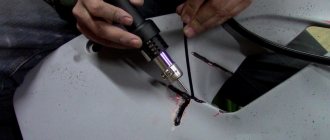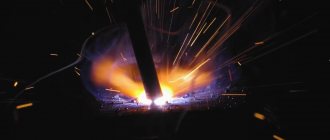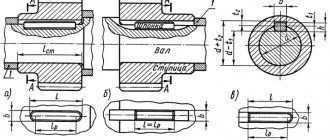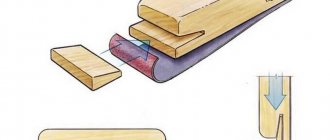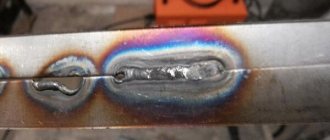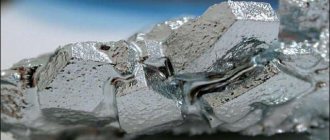Home / Welding technique
Back
Reading time: 3 min
0
1134
Non-ferrous metal and its alloys are popular in industry.
Working with them is difficult, so before gas welding products you need to learn about the characteristics of the material.
- What is the difficulty of welding non-ferrous metal?
- How to prepare for welding
- Features of welding aluminum and its alloys
- How to cook copper and nickel alloys
- Basics of welding magnesium and titanium alloys
- How to weld lead with non-ferrous metal
- How to control welding of non-ferrous metals
What is the difficulty of welding non-ferrous metal?
Non-ferrous metal is susceptible to oxidation. Refractory oxides easily get into the welding seam, causing cracks to appear.
Welding non-ferrous metals requires a lot of energy and careful monitoring of the temperature - if it cools down a little more than normal, nothing will work.
During operation, “light” elements are removed from the alloy, which have a lower melting point than the base metals.
Non-ferrous metal interacts well with gases. The oxide film that appears during the welding process prevents the creation of a strong seam.
You have to work in a room with a limited amount of oxygen.
There are practically no “pure” non-ferrous metals in products; most often you have to work with alloys of copper, aluminum, zinc and others.
Abstract on the topic “Welding of copper and its alloys”
STUDENT gr. 212
MENANY RUSTEM
ABSTRACT ON THE TOPIC:
“WELDING OF COPPER AND ITS ALLOYS”
PRIMOMORSKY INDUSTRIAL TECHNICAL SCHOOL
Welding of copper and its alloys.
Copper is used in chemical and power engineering due to its high electrical and thermal conductivity, high corrosion resistance in some aggressive environments. All these properties are higher, the higher the purity of the metal, which places special demands on welding products made of pure copper. Welding bronzes and brass has its own characteristics, but the properties of pure copper in these alloys have already been significantly lost.
Depending on the quantitative content of impurities, there are five main grades of technical copper: M0 - with a total impurity content of no more than 0.05%, M1 - no more than 0.10%, M2 - no more than 0.30%, M3 - no more than 0 .50% and M4 – with an impurity content of no more than 1.00%.
Physical and mechanical properties of copper M0:
| Density at 20°C, g/cm3 | 8,94 |
| melting point, oC | 1083 |
| latent heat of fusion, J/g | 210 |
| boiling point, oC | 2595 |
| latent heat of vaporization, J/g | 5375 |
| specific heat capacity, J/(g*oC) | 0,38 |
| thermal conductivity at 20оС, J/(cm*s*оС) | 3,83 |
| electrical resistivity, Ohm*mm2/m | 0,018 |
| temperature coefficient electrical resistance | 0,004 |
| modulus of normal elasticity, GPa | 115 |
| shear modulus, GPa | 42,4 |
| temporary tensile strength of deformed copper, MPa | 450 |
| temporary tensile strength of annealed copper, MPa | 220 |
| yield strength of deformed copper, MPa | 380 |
| yield strength of annealed copper, MPa | 70 |
| temporary tensile strength during compression of cast copper, MPa | 1570 |
| relative elongation of deformed copper, % | 5 |
| relative elongation of annealed copper, % | 47 |
| relative narrowing of deformed copper, % | 40 |
| relative contraction of annealed copper, % | 70 |
| Brinell hardness of deformed copper, MPa | 120 |
| Brinell hardness of annealed copper, MPa | 40 |
| Impact strength of cast copper at 20°C, kN*m | 1700 |
The influence of impurities on the properties of copper
Aluminum is unlimitedly soluble in molten copper; in the solid state its solubility is 9.8%. Aluminum increases the corrosion resistance of copper, reduces oxidation and reduces the electrical and thermal conductivity of copper.
Beryllium reduces the electrical conductivity of copper, increases mechanical properties and sharply reduces the oxidation of copper at elevated temperatures.
Bismuth is practically insoluble in copper. With an increased bismuth content, copper becomes brittle; Bismuth has no noticeable effect on the electrical conductivity of copper.
Iron is slightly soluble in copper in the solid state. At 1050°C up to 3.50% of iron enters the solid solution, and at 635°C its solubility drops to 0.15%. Under the influence of iron, the mechanical properties of copper increase, its electrical conductivity, thermal conductivity and corrosion resistance sharply decrease.
Oxygen is very slightly soluble in copper in the solid state. It is a harmful impurity, since its increased content significantly reduces the mechanical, technological and corrosion properties of copper.
Hydrogen has a significant effect on copper. Its solubility in copper depends on temperature: from 0.06 to 13.6 cm3/100 g of metal at temperatures of 500 and 1500 ° C, respectively. Hydrogen has a particularly destructive effect on copper containing oxygen. Such copper, after annealing in hydrogen or a reducing atmosphere containing hydrogen, becomes brittle and cracks due to the formation of water vapor from the reaction of hydrogen with cuprous oxide. The resulting water vapor does not diffuse or dissociate and, having high pressure, destroys copper.
Arsenic is soluble in copper in the solid state up to 7.5%. It significantly reduces electrical and thermal conductivity, but significantly increases the heat resistance of copper.
Lead is practically insoluble in copper in the solid state. It does not have a noticeable effect on the electrical conductivity and thermal conductivity of copper, but significantly improves its machinability.
Silver has no effect on the technical properties of copper and has little effect on its electrical and thermal conductivity.
Antimony is soluble in copper in the solid state at a eutectic temperature of 6450C up to 9.5%. Its solubility decreases sharply with decreasing temperature. Antimony significantly reduces the electrical and thermal conductivity of copper.
Sulfur dissolves in molten copper, and upon solidification its solubility decreases to zero. Sulfur slightly affects the electrical and thermal conductivity of copper and significantly reduces ductility. Under the influence of sulfur, the machinability of copper by cutting is significantly improved.
Phosphorus is limitedly soluble in copper in the solid state; The saturation limit of the α-solid solution at a temperature of 700°C reaches 1.3% phosphorus, and at 200°C it decreases to 0.4%. Phosphorus significantly reduces the electrical and thermal conductivity of copper, but has a positive effect on mechanical properties and weldability, and increases fluidity.
Tellurium is soluble in copper in the solid state up to 0.01%. Tellurium does not have a significant effect on the electrical conductivity of copper.
Selenium is slightly soluble in copper in the solid state - up to 0.1% and is released during solidification in the form of the Se2O compound. The effect on copper is similar to that of sulfur.
Classification of copper alloys.
Due to insufficient strength, commercially pure copper is rarely used as a structural material. Copper alloys - brass and bronze - are widely used in industry.
Brasses are copper alloys in which the main alloying element is zinc. Such copper-zinc alloys are usually called double brasses. To increase the mechanical properties and chemical resistance of brasses, alloying elements are often introduced into them: aluminum, nickel, manganese, silicon, etc.
Multicomponent copper-zinc alloys are usually called special brasses. Alloys of copper with tin, aluminum, silicon and other elements, among which zinc is not the main alloying element, are called bronzes. Depending on the main alloying element, two groups of bronzes are distinguished: tin bronzes and special bronzes.
Tin bronzes, depending on the content of other alloying elements in them, are divided into: tin-phosphorus, tin-zinc and tin-zinc-lead bronzes. Special bronzes are double or more complex copper-based alloys containing as additives: aluminum (aluminum bronzes), beryllium (beryllium bronzes), nickel (with the addition of iron - nickel-iron bronze), manganese (manganese bronze), silicon (silicon bronze ), cadmium (cadmium bronze), chromium (chrome bronze).
Depending on the content of other main alloying elements in aluminum bronzes, they are divided into: aluminum-manganese, aluminum-iron, aluminum-iron-manganese, aluminum-nickel bronzes. Silicon bronzes, by introducing manganese or nickel into them, are divided into: silicon-manganese and silicon-nickel.
General information on weldability
Copper, which is inert at normal temperatures, reacts with oxygen, sulfur, phosphorus and halogens when heated. With hydrogen it forms an unstable hydride CuH, with carbon it forms acetylene copper Cu2C2 (explosive); Copper does not react with nitrogen, which allows nitrogen to be used as a shielding gas for welding pure copper.
Copper under welding conditions can be oxidized due to the gas atmosphere or due to exchange reactions with components of fluxes or electrode coatings. The affinity of copper for oxygen increases when cuprous oxide is dissolved in liquid copper, especially strongly at low concentrations of Cu2O, and sharply decreases to normal during the decomposition of the liquid solution during the formation of the Cu-Cu2O eutectic; Cu2O as a separate phase is easily reduced to copper. The gases formed as a result of the reactions do not dissolve in solid copper and disrupt the metallic bond between grains, leading to the formation of cracks - “hydrogen disease” of copper.
Solid solutions of copper with oxygen have vanishingly small concentrations at low temperatures. Therefore, during the welding process, copper must be thoroughly deoxidized or welded in an environment of inert protective gases or in a vacuum.
Residual concentrations of deoxidizers affect the properties of the weld metal (electrical conductivity, thermal conductivity, corrosion resistance), and therefore, when welding products made of pure copper, the task of deoxidizing the weld metal is difficult to solve.
Welded joints made of pure copper are almost always subject to high requirements for maintaining the entire range of physical properties in the weld metal: electrical conductivity, thermal conductivity, density and corrosion resistance, since these products operate under difficult operating conditions. Therefore, during the welding process, copper should not be contaminated with any impurities that affect these properties.
Particularly high demands are placed on welding vacuum-tight seams in electronic products, in power plants, and in equipment units operating with internal cooling. The mechanical properties of welded joints are determined by the general properties of copper. Welding pure copper is significantly different from welding steel.
High thermal conductivities create high temperature gradients and cooling rates, as well as a short residence time of the weld pool in the liquid state. This necessitates the use of increased heat input when welding copper compared to steel or the use of preheating of the product, but the latter is an undesirable complication of welding technology.
The significant coefficient of linear expansion and its dependence on temperature necessitate welding when rigidly fastening the product or along tack welds. If the metal is thick, the gap width should be adjusted when welding. The short lifetime of the weld pool in the liquid state limits the possibilities of its metallurgical processing. In particular, when deoxidizing copper, more active deoxidizers are required than when welding steels to reduce the oxygen concentration to acceptable limits.
High temperature gradients promote the development of thermal diffusion of hydrogen in the heat-affected zone, which leads to the enrichment of metal near the fusion zone with hydrogen and increases the likelihood of defects (pores, cracks). The high sensitivity of copper to hydrogen must be taken into account when developing welding technology.
The choice of technological process for welding a product is primarily determined by its purpose, complexity (the presence of short or curved seams in various spatial positions, hard-to-reach places), as well as the number of manufactured products (series) and the requirements for their quality. High-performance processes include submerged arc welding and electroslag welding of thick metal and should be used in mass production or procurement operations.
With appropriate preparation of welding materials (calcination of flux to 400-4500 C), these types of welding provide good results (protection and low contamination of the weld metal, relatively low temperature gradients, reducing the influence of hydrogen). For single production and repair work, it is recommended to use gas welding, during which heating and initial heat treatment of the product are carried out. Low temperature gradients reduce the impact of the welding thermal cycle on the metal in the welding zone (seam, heat-affected zone). Possibly deoxidation and alloying of the metal through the filler wire.
Gas welding can be used for both pure copper and its alloys. Manual arc welding with coated electrodes leads to contamination of the weld metal with alloying components, which violates the physical properties of the weld metal compared to pure copper.
Welding of copper alloys (bronze) proceeds satisfactorily, but in brasses zinc is lost due to evaporation and oxidation. Gas-shielded arc welding, widely used in welding technology, is also used for the manufacture of welded products from copper and its alloys. To weld products made of pure copper, welding with a non-consumable tungsten electrode in argon, helium or nitrogen is most often used. Shielding gases must be especially pure.
The resistance of a tungsten electrode in pure nitrogen is quite satisfactory, and the use of this non-scarce and inexpensive gas provides a significant economic effect. Despite the use of inert gas protection, oxidation of copper occurs during welding, and to deoxidize it, microalloyed filler wires containing strong deoxidizers (titanium, zirconium, boron, rare earth metals) should be used. As a result, it is possible to obtain weld metal with properties at the level of pure copper.
For welding copper alloys in shielding gases (Ar and He), you can use filler wires that match the composition of the base metal or contain a small amount of deoxidizing agents (81 and Mn). Welding of copper in a shielded gas environment with a consumable electrode is used less frequently, since in this case the drops of the electrode metal are subject to significant overheating. When welding copper and its alloys with an electric arc in shielding gases, high temperature gradients are created in the welding zone and, consequently, conditions for hydrogen diffusion in the heat-affected zone.
If there is a sufficient amount of hydrogen dissolved in the base metal, defects (pores, cracks) are likely to occur. Therefore, when welding a product made of copper and its alloys, the hydrogen content in the base metal should be controlled, since its content in the fusion zone, taking into account the segregation coefficients, may be higher than permissible. Equalization of hydrogen concentrations created during the welding process is possible as a result of subsequent heat treatment.
Copper can be welded in an air atmosphere without protection, but in this case the wire must contain high concentrations of deoxidizing agents, and the weld metal, while satisfying the mechanical properties, will differ significantly from the base metal in thermal and electrical conductivity. Copper, as a metal of high ductility, can be welded well by all types of thermomechanical class welding, except resistance welding, since it has a low transient electrical resistance.
To weld leads made of thin copper wires in electronic products, thermo-compression welding is used. For larger products with complex configurations, diffusion welding in a vacuum is widely used, which makes it possible to obtain copper compounds not only with copper, but also with other metals and even non-metallic materials.
The main advantage of vacuum diffusion welding is the absence of residual stresses if homogeneous materials are welded. In the case of welding dissimilar metals, differences in the coefficients of linear expansion of the metals being joined can lead to the occurrence of thermal stresses. Cold welding of copper by plastic shear or compression deformation is used for welding copper busbars in power plants. It provides satisfactory electrical resistance of welded joints.
Gas welding
.
For copper, oxygen-acetylene welding is used, which provides the highest flame core temperature. A gas burner is a low-concentration heat source; therefore, maintaining the normal dimensions of the weld pool is difficult.
For a product with a thickness of more than 10 mm, it is recommended to use two torches, one of which provides heating, and the second serves for welding. When double-sided welding with two torches there is no need for heating.
For welding copper and bronze, a normal flame is used. Deoxidation of the metal of the weld pool, despite protection from the environment by combustion products, is carried out by extracting cuprous oxide with fluxes or introducing deoxidizers through the filler wire. Welding fluxes for copper contain boron compounds (boric acid, boric anhydride, borax), which dissolve cuprous oxide, forming a low-melting eutectic, and remove it to the slag.
In addition to boron compounds, fluxes may contain phosphates (Table 1).
Table 1. Compositions of fluxes for welding copper and its alloys, %
| Components | Fluxes | |||||
| 1 | 2 | 3 | 4 | 5 | 6 | |
| Boric acid H3BO3 | 100 | — | 50 | 25 | 35 | — |
| Anhydrous borax Na2B4O7 | — | 100 | 50 | 75 | 50 | 56 |
| Sodium biphosphate Na2HPO4 | — | — | — | — | 15 | — |
| Anhydrous potash K2CO3 | — | — | — | — | — | 22 |
| Sodium chloride NaCl | — | — | — | — | — | 12 |
Fluxes are applied to the cleaned and degreased edges to be welded, 10-12 mm per side. Additionally, they can be added using a filler metal, which is coated with flux components and liquid glass with the addition of charcoal (10-20%). When welding aluminum bronzes, fluorides and chlorides must be added to the flux to dissolve A12O3, which is obtained by the oxidation of aluminum in the bronze composition (Table 2).
For welding copper, and especially brass, it is convenient to use gaseous fluxes, which are an azeotropic solution of boron methyl ether with methyl alcohol. The vapors of this solution enter the burner through the flux feeder; the flame turns green, the organic part burns, and B2O3 interacts with the weld pool.
Table 2. Fluxes for welding aluminum bronzes
| Components | Content in fluxes, % | Components | Content in fluxes, % | ||||||
| 1 | 2 | 3 | 1 | 2 | 3 | ||||
| Chloride: sodium NaCl potassium KCl lithium LiCl | 30 45 15 | 45 30 10 | 28 50 14 | Fluoride: sodium NaCF potassium KF sodium biphosphate Na2HPO4 | — 7 3 | — 15 — | 8 — — | ||
When welding a product made of pure copper up to 3-4 mm thick, wire made of M1 or M2 copper is used, since copper does not have time to significantly oxidize. For large thicknesses of copper, filler wire alloyed with deoxidizers (up to 0.2% P and 0.3% Si) should be used for welding. The composition of the filler wire for welding copper alloys must match the composition of the base metal. The use of deoxidizers (Si, Mn, Al) is not limited as strictly as when welding copper. When welding brass, to reduce zinc losses, silicon brass (LK 80-3) should be used as a filler metal. Forging a seam after welding in a cold state for copper with a thickness of up to 4-5 mm increases the strength and plastic properties. For large thicknesses, forging is carried out after heating to 400-3000C, followed by annealing.
Welding copper with carbon electrode
.
Welding of copper and its alloys is carried out by an arc burning between the product and a carbon electrode, or an independent arc burning between two carbon electrodes. The arc discharge is the source of energy in welding. All technological methods, compositions of fluxes and filler metal remain the same as in gas welding. Using BrKMtsZ-1 wire, you can weld copper in air. The resulting compounds satisfy the requirements for mechanical properties, but the electrical and thermophysical properties will be sharply reduced. Welding of copper and its alloys with a carbon electrode is rarely used, since it is a low-productivity process.
Manual arc welding with coated electrodes
.
Manual electric arc welding with coated electrodes allows one to obtain satisfactory mechanical properties of welded joints, but the composition of the weld metal will differ significantly from the composition of the base metal due to alloying with deoxidizers during welding. When welding copper, deoxidizers are introduced into the electrode wire and into the electrode coating. The compositions of metal rods and coatings are given in tables 3, 4.
Table 3. Chemical composition (%) of copper alloys used for the manufacture of wires for electrode rods
| Wire grade | Cu | Sn | Si | Mn | P | Zn | Impurities, no more |
| M1 BrKMts3-1 BrOF4-0.25 L90 | 99.9 Rest - 88-91 | — — 3,5 — | — 2,75-3,5 — — | — 1,0-1,5 — — | — — 0,3 — | — — — Rest | 0,10 0,10 1,50 0,2 |
Table 4. Composition of electrode coatings (dry charge), %
| 3T coating | Coating K-100 |
| Manganese ore...17.0 Fluorspar...32.0 Silver graphite...16.0 Ferrosilicon...32.0 Aluminum powder...2.5 | Feldspar…12.5 Fluorspar…15.0 Ferromanganese (low carbon)…47.5 Silicon copper…20.0 |
The dry mixture is mixed on liquid glass (class A), which makes up 20-25% of the mass of the mixture. The technology corresponds to the technology for manufacturing electrodes of the basic type. The thermal and electrical conductivity of welded joints is significantly lower than that of pure copper, especially when welding with copper alloy electrodes. When welding with coated electrodes, heavy spatter occurs. The weld metal often contains pores. When welding copper and its alloys with a thickness of more than 4-5 mm, heating to 300-5000C is recommended.
Table 5. Modes of copper submerged arc welding with a carbon electrode (voltage 19 - 20 V; current 100 A)
| Thickness of welded metal, mm | Filler metal dimensions, mm | Heating time, s | Welding speed, m/h | |||
| Width | Thickness | |||||
| 5 | 12 | 5 | 3-5 | 20 | ||
| 10 | 14 | 10 | 10-15 | 6-8 | ||
Submerged Arc Welding
.
Submerged arc welding of copper and its alloys can be carried out under a layer of fused flux with a non-consumable carbon or graphite electrode, a consumable electrode and a consumable electrode under a layer of ceramic flux.
When welding with a carbon (graphitized) electrode, the electrode is sharpened in the form of a flat blade. Assembly for welding is carried out with the insertion of filler metal (brass, tombac) end-to-end to deoxidize the weld metal. Fill with calcined flux OSTS-45. Welding is carried out using direct current of reverse polarity; heating of the current is created as a result of the short circuit of the electrode to the product. Welding modes are given in Table 6.
Table 6. Submerged arc copper welding modes (M1 wire; welding speed 21 m/h)
| Metal thickness, mm | Wire diameter, mm | Voltage, V | Current, A |
| 1-2 | 1-2 | 26-27 | 160-180 |
| 5-6 | 2-3 | 28-30 | 400-500 |
Welding under fused fluxes with a consumable electrode is a highly productive method. The composition of the weld metal when welding copper changes slightly, and the metal retains its physical properties. The best results are obtained when welding with AN-M1 submerged arc, having the composition: 55% magnesium fluoride, 40% sodium fluoride, 5% barium fluoride. Wires made of M1 or MO copper are used as the electrode metal. To improve the mechanical properties of the welded joint, alloyed wires made of copper alloys BrKMtsZ-1 are also used; BrAZhMtsIu—3—1.5, but in this case the thermal and electrical conductivity of the weld metal decreases. Welding is performed using direct current of reverse polarity; The melting coefficient of the electrode wire is about 20 g/(Ah). When welding copper with a thickness of more than 15 mm, it is recommended to cut at an angle of 900 with a blunt surface or weld with a split electrode. Welding is carried out on a graphite backing or on a flux pad. The preparation of the edges and electrode wire must be thorough - cleaning to a metallic shine and degreasing. The flux must be calcined at 300-400 0C. Welding is carried out with rigid fastening or tack welding.
For welding brass grades L63 and L062-1, copper wire is used using fused flux MATI-5 or ANF-5. This welding method allows the production of welded joints from copper to steel. When welding in this case, the electrode is shifted to copper and a mode is selected so that liquid copper is in contact with the steel for a minimum time in order to avoid brittle layers (copper diffusion between steel grains).
Ceramic flux K-13 MVTU is used for welding copper, copper with steels and surfacing copper on steel. The mixture is mixed on liquid glass, granulated and, after drying, calcined for 1-2 hours at 450 0C. Welding is carried out using direct current of reverse polarity with rigid fastening on a lining made of cooled copper (up to 2.5 mm thick) or on graphite (5-6 mm thick).
The use of ceramic flux, in addition to good deoxidation of the weld metal, allows you to alloy the weld metal with the necessary components (chrome, nickel, etc.) through the flux. The electrical and thermal conductivity of the weld metal is obtained at the level of the electrical and thermal conductivity of the base metal. The mechanical properties of the welded joint also approach the properties of the base metal. For copper welding, you can also use ZhM-1 flux, which stabilizes the arc discharge well and allows welding with alternating current.
Electroslag welding of copper and its alloys
.
Welding of thick copper (30-55 mm) can be carried out using the electroslag process with a plate electrode. At IES E.O. Paton, fluxes for this process containing fluorides of alkali and alkaline earth metals have been developed. The melting point of fluxes must be lower than the melting point of copper.
Table 7. Recommended modes for welding copper with a non-consumable electrode in a shielding gas environment; butt connection on a copper lining or flux pad
| Metal thickness, mm | Gap between edges, mm | Current, A | Voltage, V | Welding speed, m/h | Heating temperature,0C | Gas consumption, l/min |
| Argon arc welding | ||||||
| 2 | 0-0,5 | 100-120 | 10-14 | 25-30 | No | 10-12 |
| 3 | 0,5-1,0 | 200-220 | 11-15 | 25-30 | No | 12-14 |
| 4 | 1,0-1,5 | 380-400 | 12-16 | 30-35 | 300-400 | 12-14 |
| Nitrogen arc welding | ||||||
| 2 | 0-0,5 | 70-90 | 20-24 | 20-22 | No | 16-18 |
| 3 | 0,5-1,0 | 120-140 | 22-26 | 20-22 | No | 18-20 |
| 4 | 1,0-1,5 | 180-200 | 24-28 | 18-20 | No | 18-20 |
| 6 | 1,0-1,5 | 260-280 | 26-30 | 16-18 | No | 20-22 |
| 8 | 1,0-1,5 | 380-400 | 30-35 | 12-14 | No | 20-22 |
| 10 | 1,0-1,5 | 400-420 | 31-36 | 12-14 | 400-600 | 22-24 |
Gas shielded arc welding
.
Automatic, semi-automatic and manual welding of copper in a shielded gas environment can be performed with consumable and non-consumable (tungsten) electrodes. Most often, for pure copper, welding with a tungsten electrode (for thicknesses up to 10 mm) with the supply of filler wire is used, less often - welding with a consumable electrode. Protective gases are used: premium argon according to GOST 10157-73, high-purity helium according to MRTU 6-02-274-66, high-purity nitrogen according to MRTU 6-02-375-66. It is most advisable to use high-purity nitrogen, in which the effective and thermal efficiency of the arc discharge is higher than for argon and helium. When welding in nitrogen, the penetration depth is higher than when welding in argon and helium, but the stability of the arc discharge in nitrogen is lower than in argon and helium. However, when welding in hard-to-reach places or when welding thin copper (
Welding of copper with a non-consumable tungsten electrode is carried out using direct current of straight polarity; They use an electrode made of lanthanum tungsten, which has satisfactory stability in protective gases, including high-purity nitrogen. When welding, the electrode is placed strictly in the plane of the joint, the inclination of the electrode is 60-80” with a “backward angle”. When welding copper with a thickness of more than 4-5 mm, heating to 300-400 0C is recommended.
When welding, filler wires made of pure copper M1 and MO provide weld metal that is close in composition and physical properties to the base metal, however, the mechanical properties of the welded joint are reduced, and porosity reduces the density of the weld metal. When deoxidizing agents and alloying components are introduced into the composition of the filler wires, the mechanical properties of the welded joint increase, but, as a rule, the thermal and electrical conductivity of the weld metal decreases, which is unacceptable when welding critical products made of pure copper. In such cases, filler wires are recommended that are alloyed with strong deoxidizers (in micro quantities), which after welding do not remain in the solid solutions, but pass into their compounds (highly dispersed, slag inclusions), and therefore do not affect the physical properties of metals. Argon-arc and nitrogen-arc welding will differ in the composition of the filler wires, since the formation of nitrides by some alloying components is possible in nitrogen.
The electrode wire and the edges of the base metal are cleaned to a shine and degreased. Copper up to 5-6 mm thick can be welded without cutting edges. To weld vacuum-tight seams, a “vacuum lock” cut is performed with mandatory welding of the root seam. Welding is carried out on pads made of calcined graphite or copper plates cooled by water. Excessive cooling of the copper backing and dew point development can cause porosity at the bottom of the weld. Copper with a thickness of more than 5 mm is welded using a flux pad. Long-length seams are welded using tacks placed in increments of 300-400 mm.
Arc welding of brass and other copper alloys containing zinc is recommended with a low nozzle. The consumption of shielding gas depends on its density and thermophysical properties (l/min): argon 8-10, helium 10-12, nitrogen.
Features of welding copper-steel bimetal, surfacing copper on the surface of steel and welding copper to steel.
When carrying out these technological operations, brittle layers may appear due to the intensive penetration of copper into the surface layers of the steel along the grain boundaries. The penetration process is determined by the temperature and time of contact of liquid copper with solid steel.
To reduce the penetration of copper along the grain boundaries, the process of welding copper with steel or the process of surfacing copper on steel must be carried out at a minimum heat input and with a minimum penetration depth, using additional cooling to accelerate the crystallization of the copper layer. Copper surfacing on steel can be done using various welding methods, observing the above conditions.
Good results can be obtained by submerged arc surfacing with a consumable electrode fed by an automatic head that oscillates in a plane perpendicular to the incoming motion. The steel surface can be cooled from the side opposite to the surfacing, or the surfacing metal can be cooled directly using water-cooled devices.
When surfacing copper in an argon environment with a consumable electrode, similar conditions should be observed. When welding copper to steel with a consumable electrode, the electrode must be deflected towards the copper, since the magnetic blast during the welding process will return the arc discharge to the edges being welded. When welding, it is necessary to use minimum currents to ensure the formation of a weld. Welding of copper-steel bimetal can be carried out from the cladding layer side or from the steel side.
In the first case, it is inevitable to remove the cladding layer on the joining edges, welding the steel, cleaning the resulting seam and surfacing copper on the steel to restore the cladding layer. If welding is possible on the steel side, the copper cladding layer in the welding zone is not removed; After welding the steel, the joint is welded on the cladding layer using any method.
How to prepare for welding
To begin with, the parts are prepared: fats are removed from the surface, non-ferrous metal is cleaned of the oxide film. The parts are laid out on a flat surface at a distance of no more than two millimeters. Non-ferrous metal is fluid, so you need to work as low as possible.
It is necessary to avoid the entry of air during operation, so they cook using helium or nitrogen - inert gases. Electrodes are made of graphite, carbon or tungsten.
How to cook copper and nickel alloys
Nickel is a heat-resistant material, so it is used in the production of rockets and gas pipelines. The operating temperature for its alloy is 700−1000°C, the material is durable, ductile, but very picky about the choice of gas environment.
This sensitivity can result in porous seams.
Nickel is not affected by corrosion. You can degrease everything except gasoline. For welding, metal electrodes and reverse polarity current are chosen. When using an argon cooker, tungsten electrodes are used.
Copper is used to make spare parts for mechanical engineering, as well as in the production of pipes. The work uses direct polarity current and carbon and graphite electrodes. When manual welding under heating up to 400°C, the current should be of reverse polarity, the arc size should be up to 40 mm.
Bronze wire is used for the additive; helium and argon have shown themselves to work well as shielding gases. When preparing for welding, you need to clean the edge so that the non-ferrous metal shines.
Cook quickly without stopping. If there is no bronze, you can use copper for the additive.
Powders or vapors from fluxes are used to protect the weld pool.
Welding technology
20 seconds before ignition of the arc, gas begins to flow. During operation, the parts are first secured with spot welds. After this, a continuous connection is formed and it is cleaned of traces of scale and slag.
Why is it best to use argon arc welding?
This method is considered optimal for joining non-ferrous metals. Heavy argon easily displaces air from the weld pool, providing reliable protection. The inertness of the gas does not allow it to react with metal, oxygen and nitrogen.
We recommend reading Welding copper and its alloys at home
Argon arc welding is divided into:
- manual methods using tungsten rods;
- automatic methods compatible with any type of electrodes.
More about different metals
The welding method is chosen taking into account the physical and chemical characteristics of the metal. Also take into account:
- availability of necessary equipment;
- experience as a welder;
- cost of the procedures performed.
The possibility of using welding methods for different metals is reflected in the table:
| Metal name | Dugovaya | In an argon environment | Electroslag | Electron beam | Gas |
| Aluminum | + | + | + | + | + |
| Magnesium | + | + | – | – | – |
| Copper | + | + | + | + | |
| Titanium | + | + | + | + | – |
| Nickel | + | + | + | – | – |
| Tantalum | – | + | + | – | – |
| Zirconium | – | + | + | – | – |
| Molybdenum | – | + | + | – | – |
| Hafnium | – | + | + | – | – |
| Tungsten | – | + | + | – | – |
| Niobium | – | + | + | – | – |
| Silver | + | + | + | – | – |
| Zinc | + | + | + | – | – |
| Lead | + | + | + | – | + |
